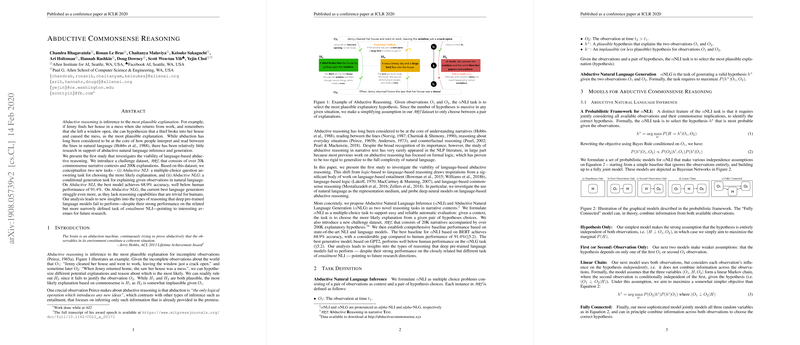Analysis of Abductive Commonsense Reasoning in LLMs
The presented paper details research that explores the potential for language-based abductive reasoning, specifically within the scope of NLP. This paper addresses a significant gap in existing NLP research by focusing on abductive reasoning—a method of inference aimed at identifying the most plausible explanation for a given set of observations, a process central to human commonsense understanding and narrative interpretation.
Key Contributions
The research introduces two new tasks designed to assess systems on abductive reasoning: Abductive Natural Language Inference (ANLI) and Abductive Natural Language Generation (ANLG). For the ANLI task, models choose between multiple hypotheses to identify which explanation best fits the provided narrative context. In contrast, the ANLG task challenges models to generate plausible explanations suited for given observations.
Central to this work is a novel dataset, consisting of approximately 20,000 narrative contexts and 200,000 hypotheses. This dataset provides a benchmark for evaluating AI's ability to perform abductive reasoning in written narratives, where traditional deductive or inductive reasoning may fall short.
Experimental Findings
Several experiments were conducted using state-of-the-art models such as BERT and GPT. Results indicate that while these models achieve moderate success, with the best performance resulting in 68.9% accuracy on ANLI tasks and considerably lower scores on ANLG tasks, there is still a marked gap compared to human-level performance, which averages 91.4% accuracy on similar tasks.
The models’ struggles in ANLG tasks, achieving only about 45% human acceptance in generations, highlight the difficulty of replicating human commonsense reasoning in AI. This reveals a deficiency in the models' capability to generate coherent and commonsensical hypotheses akin to human-written narratives.
Implications and Future Directions
The research holds substantial implications for both practical applications and theoretical advancements in AI. Practically, enhanced abductive reasoning could improve AI's ability to engage in more human-like narrative interpretations, benefiting applications in storytelling AI, autonomous agents, and interactive user interfaces. Theoretically, this paper suggests future avenues in improving AI reasoning through more robust models capable of intricate cognitive functions like abduction.
For future research, focusing on integrating a richer form of commonsense reasoning into model architectures could prove beneficial. Enhancements may involve incorporating external commonsense knowledge bases or developing novel machine learning solutions that allow models to better infer intricate associations that mimic human abductive reasoning processes.
Conclusion
In conclusion, this paper makes a significant step towards addressing the shortcomings of current LLMs in performing abductive reasoning. By focusing on a less-explored area within AI and NLP research, this paper lays foundational work for the development of more cognitively advanced AI systems. The tasks and datasets introduced will likely serve as important benchmarks for future studies aiming to bridge the gap between human and machine reasoning capabilities.
